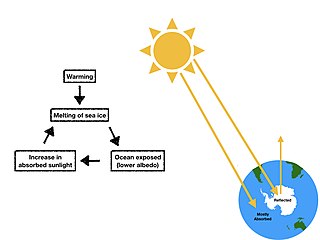 W
WAlbedo is the measure of the diffuse reflection of solar radiation out of the total solar radiation and measured on a scale from 0, corresponding to a black body that absorbs all incident radiation, to 1, corresponding to a body that reflects all incident radiation.
 W
WArctic methane release is the release of methane from seas and soils in permafrost regions of the Arctic. While it is a long-term natural process, methane release is exacerbated by global warming. This results in negative effects, as methane is itself a powerful greenhouse gas.
 W
WClimate change feedback is important in the understanding of global warming because feedback processes may amplify or diminish the effect of each climate forcing, and so play an important part in determining the climate sensitivity and future climate state. Feedback in general is the process in which changing one quantity changes a second quantity, and the change in the second quantity in turn changes the first. Positive feedback amplifies the change in the first quantity while negative feedback reduces it.
 W
WClimate sensitivity is a measure of how much the Earth's climate will cool or warm after a change in the climate system, for instance, how much it will warm for doubling in carbon dioxide concentrations. In technical terms, climate sensitivity is the average change in the Earth's surface temperature in response to changes in radiative forcing, the difference between incoming and outgoing energy on Earth. Climate sensitivity is a key measure in climate science, and a focus area for climate scientists, who want to understand the ultimate consequences of anthroprogenic climate change.
 W
WCyclonic Niño is a climatological phenomenon that has been observed in climate models where tropical cyclone activity is increased. Increased tropical cyclone activity mixes ocean waters, introducing cooling in the upper layer of the ocean that quickly dissipates and warming in deeper layers that lasts considerably more, resulting in a net warming of the ocean.
 W
WThe Gaia Paradigm, also known as the Gaia theory or the Gaia principle, proposes that living organisms interact with their inorganic surroundings on Earth to form a synergistic and self-regulating, complex system that helps to maintain and perpetuate the conditions for life on the planet.
 W
WIce–albedo feedback is a positive feedback climate process where a change in the area of ice caps, glaciers, and sea ice alters the albedo and surface temperature of a planet. Ice is very reflective, therefore some of the solar energy is reflected back to space. Ice–albedo feedback plays an important role in global climate change. For instance at higher latitudes, we see warmer temperatures melt the ice sheets. However, if warm temperatures decrease the ice cover and the area is replaced by water or land the albedo would decrease. This increases the amount of solar energy absorbed, leading to more warming. The effect has mostly been discussed in terms of the recent trend of declining Arctic sea ice. The change in albedo acts to reinforce the initial alteration in ice area leading to more warming. Warming tends to decrease ice cover and hence decrease the albedo, increasing the amount of solar energy absorbed and leading to more warming. In the geologically recent past, the ice-albedo positive feedback has played a major role in the advances and retreats of the Pleistocene ice sheets. Inversely, cooler temperatures increase ice, which increases albedo, leading to more cooling.
 W
WThe lapse rate is the rate at which an atmospheric variable, normally temperature in Earth's atmosphere, falls with altitude. Lapse rate arises from the word lapse, in the sense of a gradual fall.
 W
WThe permafrost carbon cycle is a sub-cycle of the larger global carbon cycle. Permafrost is defined as subsurface material that remains below 0o C for at least two consecutive years. Because permafrost soils remain frozen for long periods of time, they store large amounts of carbon and other nutrients within their frozen framework during that time. Permafrost represents a large carbon reservoir that is seldom considered when determining global terrestrial carbon reservoirs. Recent and ongoing scientific research however, is changing this view.
 W
WThe soil carbon feedback concerns the releases of carbon from soils in response to global warming. This response under climate change is a positive climate feedback. There is approximately two to three times more carbon in global soils than the Earth's atmosphere, which makes understanding this feedback crucial to understand future climate change. An increased rate of soil respiration is the main cause of this feedback, where measurements imply that 4 °C of warming increases annual soil respiration by up to 37%.
 W
WA tipping point in the climate system is a threshold that, when exceeded, can lead to large changes in the state of the system. Potential tipping points have been identified in the physical climate system, in impacted ecosystems, and sometimes in both. For instance, feedback from the global carbon cycle is a driver for the transition between glacial and interglacial periods, with orbital forcing providing the initial trigger. Earth's geologic temperature record includes many more examples of geologically rapid transitions between different climate states.